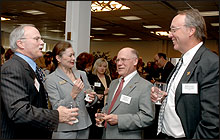Archives
UB 2020 seen as model for change
Simpson predicts UB’s strategic planning process will guide other institutions
By ARTHUR PAGE
Assistant Vice President
go to the UB2020 website
Based on the successes to date of UB 2020, President John B. Simpson predicts that the university's strategic planning process not only will serve as a future model for other SUNY campuses, but that other U.S. public universities will consider emulating the "UB model."

UB 2020, according to Simpson, "is a model with the potential to dispel for good the antiquated notion that achieving efficiency in academic services means accepting a reduction in those services. And it will do away with the outdated idea that scholarly achievement comes only from excellence within one's narrow discipline or department.
"UB 2020 is about UB, to be sure. But what we have begun can be, and should be, much bigger than just our university. We have a leadership role to play in the public higher education community, and we are playing it."

From left, President John B. Simpson and Katherine L. Gower chat with University Facilities staff members Lou Schmitt and Mike Dupre at a reception held to thank UB faculty and staff who have been most involved in the UB 2020 planning process during the past year.
PHOTO: NANCY J. PARISI
Simpson made these comments at a reception held April 19 in the Center for Tomorrow where he thanked faculty and staff who have been most involved in the effort during the past year.
He thanked those gathered "for the important and groundbreaking work you are doing to advance UB forward in its overarching goal—to be recognized throughout the nation and the world as one of the premier public research institutions of the 21st century."
UB 2020, he added, "is about moving beyond the traditional model of institutional organization that characterizes most colleges and universities. It's about exploring new interdisciplinary fields of inquiry, fostering innovative collaborations across disciplinary lines and forging new strategic partnerships—not just within the academic sphere, but beyond it as well."
Recapping progress during the past year, Simpson noted the consolidation of campus offices responsible for the administration of sponsored program activity into a single comprehensive organization, the Office of Sponsored Projects Services, and the fact that six strategic strengths have moved from the initial planning phases into the implementation phase. He also noted that the IT Strategic Transformation Committee has recommended strategies for improving delivery of IT services and that the HR Strategic Transformation group has moved into the implementation phase.
Looking to the future, Simpson said his first objective is increasing the size of UB's faculty by 253 new hires over the next five years. "This goal," he added, "is really the basis of all of our succeeding objectives we seek to fulfill through UB 2020." Those goals, he said, are:
Growing enrollment while increasing student selectivity
Enhancing research strengths and resources through the development of the strategic strength areas
Redesigning campus operations and organizational plans
Expanding external fund-raising efforts, securing increased state funding and pursuing new opportunities to generate campus revenue in support of this growth.
"What will the progress bring?" he asked. "More students and faculty, more scholarship, more research dollars, higher rankings, stronger relations with Western New York and the many 'publics' we serve in our region and beyond."
